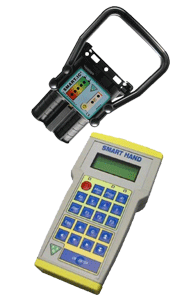Click on each practice to find more information about it:
Batteries pose a health threat in several ways.
- Shear weight, batteries weigh as much as 3000lbs or more
- Gases emitted during charging can be highly volatile
- Corrosive chemicals include sulphuric acid
For these reasons, battery charging stations and the employees that work around them must be properly equipped and certain safety procedures implemented.
To protect workers from danger associated with the battery’s weight, the batteries should only be removed and replaced from the forklifts using an appropriately equipped forklift or battery cart specifically designed for transporting batteries.
Batteries that are being removed or replaced should be securely placed and restrained in the cart or the forklift. Use the correct tools and follow proper procedures when moving batteries. This will ensure that the battery does not fall.
Batteries release oxygen and hydrogen gases when they are charging. This effect, called “gassing” is more noticeable if the battery is being overcharged. In the right concentrations, these gases can be highly explosive. Due to this “gassing” effect, charging stations should be located in well-ventilated areas to prevent concentrations of hydrogen and oxygen from reaching volatile levels. General or local ventilation can be provided by a fume hood or an exhaust fan. If an on-board charging system is used, the industrial truck itself should be parked in a location where there is adequate ventilation.
Sulfuric acid is a common and hazardous component in a battery. In the event of a battery acid spill, neutralizing agents should be spread on the spill. These cleanup materials should be on hand at all times. After the spill is neutralized, it can be safely cleaned up and disposed of in accordance with local ordinances. Only properly trained and authorized employees should perform an acid cleanup.
Whenever changing or servicing a battery, personal protective equipment (PPE) should be worn to prevent harm if an accident should occur. The first area of concern is the weight of the battery. To protect workers against drops, proper footwear like steel-toe boots or foot guards should be worn.
Maintaining batteries by adding water also requires appropriate protection. Chemical-resistant gloves, acid apron, eyewear and face protection are a must. They will reduce the risk of injury should an acid splash occur. As stated by OSHA 29 CFR 1910.133, “…protective eye and face equipment must be available where there is a good chance that injuries could be prevented by using such equipment…” Face protection must meet the ANSI Z87.1-1989 specifications or be proven equally effective. Face-shields are considered as secondary eye protection only. Indirect or non-vented safety goggles should also be worn to protect the eyes.
An eye/face wash and shower are other required pieces of equipment that must be in or near a battery changing area. According to OSHA 29 CFR 1910.151, “…where the eyes or body of any person may be exposed to injurious corrosive materials, suitable facilities for quick drenching or flushing of the eyes and body shall be provided within the work area for immediate emergency use.” According to ANSI Z358.1-1998, the eye/face wash and shower must be within 10 seconds in distance of the hazard and on the same level as that hazard. This unit needs to be clearly identified with proper signs and adequate lighting.
In order to insure that battery changes are performed safely, certain steps should be taken. In 29 CFR 1910.178, OSHA has called out a basic battery charging and changing guidelines that include:
Changing and charging storage batteries.
- Battery charging installations shall be located in areas designated for that purpose.
- Facilities shall be provided for flushing and neutralizing spilled electrolyte, for fire protection, for protecting charging apparatus from damage by trucks, and for adequate ventilation for dispersal of fumes from gassing batteries.
- A conveyor, overhead hoist, or equivalent material handling equipment shall be provided for handling batteries.
- Reinstalled batteries shall be properly positioned and secured in the truck.
- Trucks shall be properly positioned and brake applied before attempting to change or charge batteries.
- Care shall be taken to assure that vent caps are functioning. The battery (or compartment) cover(s) shall be open to dissipate heat.
- Smoking shall be prohibited in the charging area.
- Precautions shall be taken to prevent open flames, sparks, or electric arcs in battery charging areas.
- Tools and other metallic objects shall be kept away from the top of uncovered batteries.
- Protective eye and face equipment must be available and used whenever battery maintenance or inspections are performed.
Sources for more information:
- 29 CFR 1910.178, Powered Industrial Trucks
- 29 CFR 1910.151, Medical Services and First Aid
- ANSI/ASME B56.1-1993, Safety Standards for Low Lift and High Lift Trucks
- ANSI/NFPA 505, Powered Industrial Trucks Including Type, Area of Use, Maintenance and Operation
- Powered Industrial Truck Owner’s Manual
- ANSI Z358.1-1998
 SMART IC
SMART IC
SMART IC Battery and Charger Inter-Communicator is the most advanced battery tracking and charging system in the world.
The Smart IC (Inter Communicator) Module is the most advanced way of tracking and maintaining complete battery use in Real-Time using GPRS Technology.
All battery information usage including detailed shift discharge maneuvers (lifts) are tracked by the second.
Performance, Maintenance and Daily Charge Parameters can be manipulated for the most efficient and cost effective fleet possible.
Benefits Include:
- Off-peak-hour Energy Savings
- On-line, Full-time Maintenance Scheduling
- Immediate Battery or Charger Fault Indication
The SMART IC’s GPRS Tracking System allows for Global Tracking possibilities to a PC. For individual data recovery, the SMARTHAND provides an excellent industrial-duty device for easy uploading to any PC.

